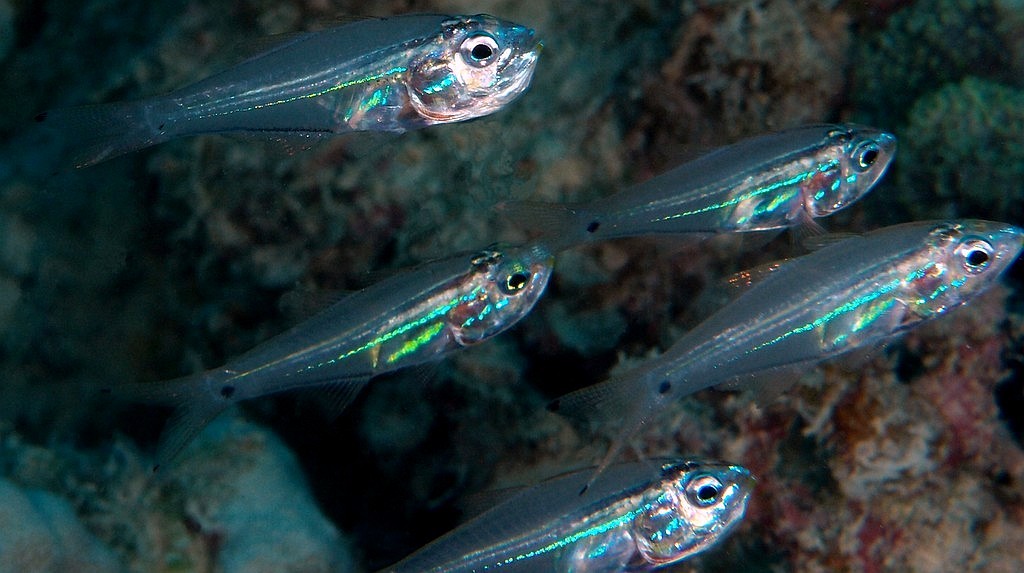RHABDAMIA GRACILIS - (BLEEKER, 1856)
Actinopterygii (Gigaclass) > Actinopteri (Class) > Teleostei (Subclass) > Gobiiformes (Order) > Apogonoidei (Suborder) > Apogonidae (Family) > Apogoninae (Subfamily) > Rhabdamia (Genus)
Poisson cardinal lumineux, Arrow cardinal, Graceful cardinalfish, Luminous cardinalfish, Slender cardinal, Slender cardinalfish, Pyl-kardinaal, Sukashitenjikudai, スカシテンジクダイ, 大目侧仔, 箭天竺鯛,
Synonymes
Apogon gracilis (Bleeker, 1856)
Apogonichthys gracilis (Bleeker, 1856)
Apogonichthys mentalis (Evermann & Seale, 1907)
Apogonichthys nudus (Regan, 1905)
Rhabdamia clupeiformis (Weber, 1909)
Rhabadamia gracilis (Bleeker, 1856)
Poisson cardinal lumineux, Arrow cardinal, Graceful cardinalfish, Luminous cardinalfish, Slender cardinal, Slender cardinalfish, Pyl-kardinaal, Sukashitenjikudai, スカシテンジクダイ, 大目侧仔, 箭天竺鯛,
Synonymes
Apogon gracilis (Bleeker, 1856)
Apogonichthys gracilis (Bleeker, 1856)
Apogonichthys mentalis (Evermann & Seale, 1907)
Apogonichthys nudus (Regan, 1905)
Rhabdamia clupeiformis (Weber, 1909)
Rhabadamia gracilis (Bleeker, 1856)
-----------------------
Description
Dorsal spines (total): 7; Dorsal soft rays (total): 9; Anal spines: 2; Anal soft rays: 12-13; Pectoral fins rays: 13; Lateral line scales: 23-24; Predorsal scales: 4; Gill rakers: 6 + 21; Greatest depth of body: 3.3-3.6 in SL; Head long: 2.6 in SL; Eyes diameter: 3.0 in Head Long; Scales cycloid and deciduous; Viliform teeth on jaws, those on womer slightly larger; Few or no teeth on palatines; Caudal forked. Max. length: 6.0 cm TL. Depth range: 1 - 90 m.
Color
Translucent whitish to pinkish, head and abdomen silvery; Bluish midlateral stripe; Posteriorly placed black spot; Sometimes on caudal peduncle; One or both caudal-fin lobes with black tip.
Etymology
Rhabdamia: from Greek, rhabdos = stick + from Greek, amia, -as = a kind of bonito. Name given by Aristotle to a fish (Later name applied to Apogon by Gronow (1763), now a commonly used suffix in the family).
gracilis: from Latin, gracilis = thin, slender, slim. Referring to its slender and elongate (for an apogonid) body.
Original description: Apogonichthys gracilis Bleeker, 1856 - Type locality: Ternate, Molucca Islands, Indonesia.
Distribution
Indo-West Pacific: East Africa (Somalia, Mozambique), Comoros, Madagascar and Mascarenes (Mauritius), east to Marshall Islands and Fiji, north to southern Japan, south to Western Australia, Queensland (Australia) and New Caledonia.
Description
Dorsal spines (total): 7; Dorsal soft rays (total): 9; Anal spines: 2; Anal soft rays: 12-13; Pectoral fins rays: 13; Lateral line scales: 23-24; Predorsal scales: 4; Gill rakers: 6 + 21; Greatest depth of body: 3.3-3.6 in SL; Head long: 2.6 in SL; Eyes diameter: 3.0 in Head Long; Scales cycloid and deciduous; Viliform teeth on jaws, those on womer slightly larger; Few or no teeth on palatines; Caudal forked. Max. length: 6.0 cm TL. Depth range: 1 - 90 m.
Color
Translucent whitish to pinkish, head and abdomen silvery; Bluish midlateral stripe; Posteriorly placed black spot; Sometimes on caudal peduncle; One or both caudal-fin lobes with black tip.
Etymology
Rhabdamia: from Greek, rhabdos = stick + from Greek, amia, -as = a kind of bonito. Name given by Aristotle to a fish (Later name applied to Apogon by Gronow (1763), now a commonly used suffix in the family).
gracilis: from Latin, gracilis = thin, slender, slim. Referring to its slender and elongate (for an apogonid) body.
Original description: Apogonichthys gracilis Bleeker, 1856 - Type locality: Ternate, Molucca Islands, Indonesia.
Distribution
Indo-West Pacific: East Africa (Somalia, Mozambique), Comoros, Madagascar and Mascarenes (Mauritius), east to Marshall Islands and Fiji, north to southern Japan, south to Western Australia, Queensland (Australia) and New Caledonia.
Biology
Forms large dense schools in gutters and above the reef. Feeds on plankton above the reef during the day and at night.
Forms large dense schools in gutters and above the reef. Feeds on plankton above the reef during the day and at night.
Similar species
Rhabdamia novaluna (Yoshida, Mabuchi & Motomura, 2018) - Reported from Western Pacific: Japan, Marshall Islands, Indonesia, Papua New Guinea, Solomon Islands, Australia and Fiji. Body transparent pale greyish, reflective silvery on head and abdomen, with bluish white and blackish mid-lateral lines. Show a subdermal black blotch or spot on the lower caudal peduncle.
Rhabdamia spilota (Allen & Kuiter, 1994) - Reported from New Caledonia. Differs from Rhabdamia gracilis, in having more gill rakers on the first gill arch (modally 30-31 developed gill rakers, vs. 24 in Rhabdamia gracilis), a black stripe from the jaw tips to the anterior margin of the orbit (vs. snout and tip of lower jaw with black pigmentation in Rhabdamia gracilis), 3-6 reddish-brown to blackish blotches on the opercle and anterior of the body (vs. blotches absent in Rhabdamia gracilis), and indistinct black pigmentation restricted to the outer margins of the caudal fin (vs. pigmentation scattered over entire fin in Rhabdamia gracilis).
Rhabdamia novaluna (Yoshida, Mabuchi & Motomura, 2018) - Reported from Western Pacific: Japan, Marshall Islands, Indonesia, Papua New Guinea, Solomon Islands, Australia and Fiji. Body transparent pale greyish, reflective silvery on head and abdomen, with bluish white and blackish mid-lateral lines. Show a subdermal black blotch or spot on the lower caudal peduncle.
Rhabdamia spilota (Allen & Kuiter, 1994) - Reported from New Caledonia. Differs from Rhabdamia gracilis, in having more gill rakers on the first gill arch (modally 30-31 developed gill rakers, vs. 24 in Rhabdamia gracilis), a black stripe from the jaw tips to the anterior margin of the orbit (vs. snout and tip of lower jaw with black pigmentation in Rhabdamia gracilis), 3-6 reddish-brown to blackish blotches on the opercle and anterior of the body (vs. blotches absent in Rhabdamia gracilis), and indistinct black pigmentation restricted to the outer margins of the caudal fin (vs. pigmentation scattered over entire fin in Rhabdamia gracilis).
Last update: 22, March 2023
